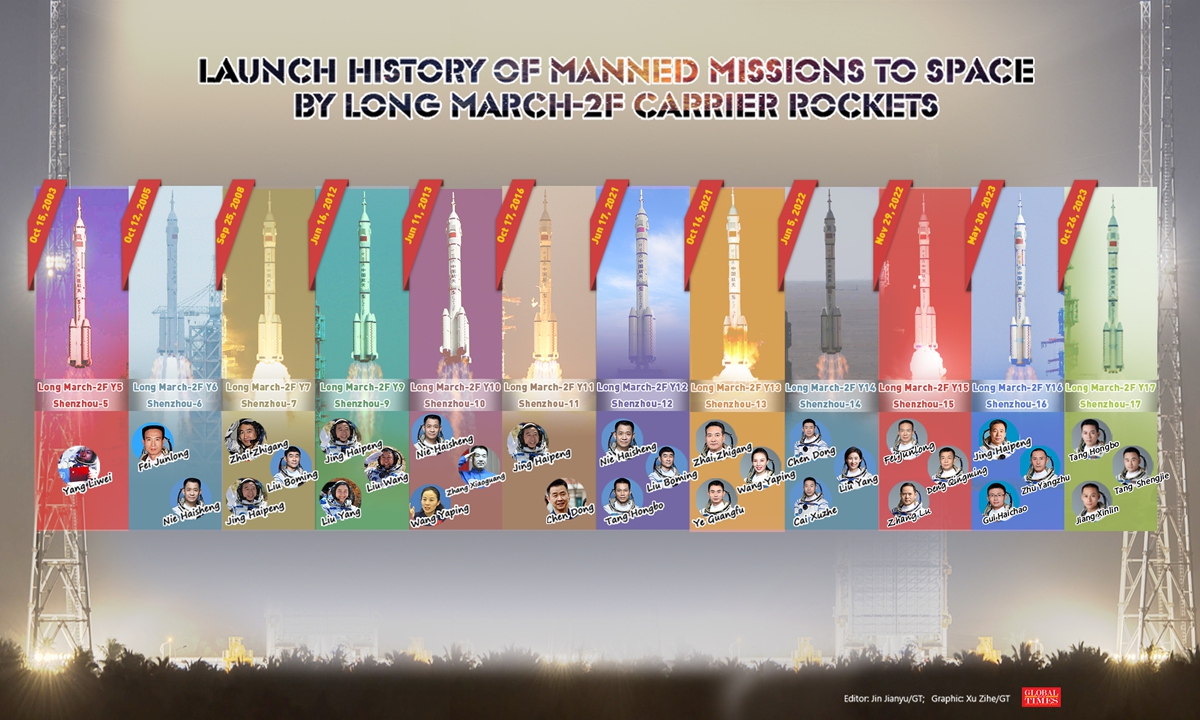On the momentous occasion of the 20th anniversary of China's first manned spaceflight the Shenzhou-5, the Shenzhou-17 spacecraft soared into the sky from the Jiuquan Satellite Launch Center in Northwest China on Thursday morning at 11:14 am.
Sitting atop the Long March-2F Y17 carrier rocket, the spacecraft, carrying taikonauts Tang Hongbo, Tang Shengjie, and Jiang Xinlin, embarked on the journey toward the China Space Station. Following a smooth flight of around 10 minutes , the Shenzhou-17 spacecraft entered its planned orbit, marking a successful launch, according to the official release by the China Manned Space Agency (CMSA.)
The average age of the crew of taikonauts of Shenzhou-17 mission is a markedly young at 39, setting a record for China's manned space history.
The Shenzhou-17 spacecraft is now on its way to the China Space Station, and according to the mission plan, it will carry out a fast rendezvous and docking with the Tianhe space station core module at the front port around 6.5 hours after liftoff.
The Tiangong space station is hours away from staging another a great feat of an in-orbit reunion of six taikonauts, continuing the new norm for the China Space Station with permanent occupation of taikonauts, mission insiders hailed.
The collaboration between the two crew groups will mark a significant step in China's ongoing space exploration endeavors, reinforcing its capability and commitment to long-term space habitation and research, they noted.
This year marks the 20th anniversary of China's first manned spaceflight mission the Shenzhou-5. In the past 20 years, China has carried out 12 such crewed missions including the latest Shenzhou-17 mission, with a perfect success rate.

Launch history of manned missions to space by Long March-2F carrier rockets
Since its inaugural flight in 1999, the Long March 2F rocket, the country's first and only manned carrier rocket, has maintained a flawless record.
Through continuous efforts to address weak links and optimize technical conditions, the reliability assessment of Long March 2F rocket has now increased to 0.9896, with a safety assessment value reaching 0.99996. This showcases the rigorous enhancements and technical advancements that have been implemented to ensure the rocket's reliability and safety over the years, the rocket developer the state-owned China Academy of Launch Vehicle Technology (CALT) told the Global Times on Thursday.
Currently, the "one-launch-one-standby" launch process of the Long March 2F rocket has been compressed from 49 days during the initial construction phase of the space station to 35 days. Now, efforts are underway to further optimize and improve the process aiming for a 30-day target, to better meet the demands of the space station's application and development phase, developers said.
According to them, in the coming years, the Long March 2F rocket is set to continue its high-frequency launch schedule with two launches per year. It will play a crucial role in the operation of China's space station, demonstrating its pivotal role in supporting the country's ambitious space exploration and operation endeavors.
The Shenzhou-17 crewed flight mission, the 30th flight mission since the establishment of China's manned space program in 1992, has some crucial objectives.
The mission's primary goal includes completing the in-orbit crew rotation with the Shenzhou-16 trio, before they carry on to conduct an approximate six-month stay in space until April 2024.
During this period, the crew will engage in on-orbit trials of space science and application payloads, conduct extravehicular activities, commonly known as spacewalks, and perform payload extravehicular operations, which according to the CMSA, will also involve the installation of extravehicular payloads and maintenance tasks on the space station.
Moreover, the mission will continually evaluate the functional performance of the space station assembly, accumulating precious data and experience regarding space station operations. This initiative aims to assess the coordination and compatibility of the ground support center in managing space station operational tasks, thereby enriching the operational efficiency and troubleshooting capabilities of the space station, the CMSA said.
A significant highlight of the Shenzhou-17 mission is the pioneering experimental extravehicular repair operations to be undertaken on the space station, which will be a historic first.
Also, the Shenzhou-17 mission will carry a significant "Space Protein Molecular Assembly and Application Research" project, the Global Times learned from the space application system personnel on Thursday.
Aiming to advance humanity's health, the project encompasses 29 samples across five categories: proteins, polypeptides, nucleic acids, biological materials, and pharmaceutical materials. Samples include insulin, cancer treatment protein complexes, nano-hydroxyapatite/collagen polypeptide, and lysozyme, which were transferred to the launch tower about eight hours before launch, and placed inside the Shenzhou spacecraft to be launched into space, Cang Huaixing, a research fellow with the Center for Space Application Engineering and Technology, under the Chinese Academy of Sciences, told the Global Times.

